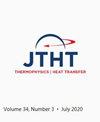Effect of Inlet Geometry on Film-Cooling Effectiveness from Shaped Holes
IF 1.1
4区 工程技术
Q4 ENGINEERING, MECHANICAL
引用次数: 0
Abstract
Modern gas turbine engines require a sophisticated cooling system design to achieve higher power output and efficiency. This study investigates the potential effect of noncylindrical inlet geometries on the performance of laid-back, fan-shaped film-cooling holes using the pressure-sensitive paint measurement technique on a flat plate. On the basis of a common pattern of outlet geometry, racetrack-shaped inlet geometries with aspect ratios of 2:1 and 4:1 were tested along with traditional cylindrical inlets. The coolant flow conditions range from [Formula: see text] = 0.3–1.5 and DR = 1 and 2. The mainstream turbulence intensity is held at 6%. Test results show that the shaped inlets provide a higher area-averaged film-cooling effectiveness over the cylindrical inlet using the same amount of coolant. For the 2:1 inlet, an advantage of 20% higher effectiveness could be maintained for DR = 1, while for DR = 2 this advantage is reduced to 10%. For the 4:1 inlet, when the coolant momentum flux ratio [Formula: see text] < 0.5, a similar or slightly higher improvement can be obtained, but when [Formula: see text] > 1, the advantage diminishes with the growing I to approximately 5%, at [Formula: see text] = 2.25. Regarding discharge coefficients, the 2:1 inlet geometry is similar to the cylindrical inlet. For the 4:1 inlet, it is 2–5% lower or nearly equivalent.入口几何形状对异形孔薄膜冷却效果的影响
现代燃气涡轮发动机需要复杂的冷却系统设计,以实现更高的功率输出和效率。本研究利用平板上的压敏涂料测量技术,研究了非圆柱形进气道几何形状对平铺式扇形薄膜冷却孔性能的潜在影响。在常见的出口几何形状基础上,测试了纵横比为 2:1 和 4:1 的赛道形入口几何形状以及传统的圆柱形入口。冷却剂流动条件为[公式:见正文] = 0.3-1.5 和 DR = 1 和 2。主流湍流强度保持在 6%。测试结果表明,在使用相同冷却剂量的情况下,异形进气口比圆柱形进气口具有更高的面积平均膜冷却效果。对于 2:1 的进气口,在 DR = 1 的情况下,可以保持高出 20% 的效率优势,而在 DR = 2 的情况下,这一优势降低到 10%。对于 4:1 进气口,当冷却剂动量通量比[计算公式:见正文]为 1 时,随着 I 的增大,[计算公式:见正文]= 2.25 时的优势减小到约 5%。关于排出系数,2:1 进气口的几何形状与圆柱形进气口相似。对于 4:1 的进气口,则低 2-5%,或几乎相等。
本文章由计算机程序翻译,如有差异,请以英文原文为准。
求助全文
约1分钟内获得全文
求助全文
来源期刊

Journal of Thermophysics and Heat Transfer
工程技术-工程:机械
CiteScore
3.50
自引率
19.00%
发文量
95
审稿时长
3 months
期刊介绍:
This Journal is devoted to the advancement of the science and technology of thermophysics and heat transfer through the dissemination of original research papers disclosing new technical knowledge and exploratory developments and applications based on new knowledge. The Journal publishes qualified papers that deal with the properties and mechanisms involved in thermal energy transfer and storage in gases, liquids, and solids or combinations thereof. These studies include aerothermodynamics; conductive, convective, radiative, and multiphase modes of heat transfer; micro- and nano-scale heat transfer; nonintrusive diagnostics; numerical and experimental techniques; plasma excitation and flow interactions; thermal systems; and thermophysical properties. Papers that review recent research developments in any of the prior topics are also solicited.
 求助内容:
求助内容: 应助结果提醒方式:
应助结果提醒方式:


